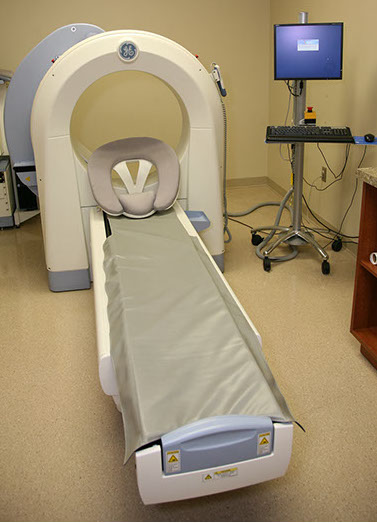List of in-house testing and diagnostics
General Testing
The testing below is very important to your health and diagnosing possible clinical problems with your health. These tests are most common and are all performed in our office.
This test is a bit of a work out. You will have leads attached to you just like you were getting an EKG (Electrocardiogram) and a blood pressure cuff. You will walk on a treadmill slowly at first and increasing in speed and incline every three minutes. This test mainly shows your heart rhythm while exercising. This test takes about 45 minutes; however, you will only be on the treadmill for approximately 10 minutes.
I am coming in for this test, what can I expect?
Have a light meal only. Have nothing to eat two hours prior to the test. Wear comfortable clothes (two piece outfit) and tennis shoes. Expect to be at Seale Harris Clinic for an hour or two because the doctor will talk to you about your results after your test.
Indications:
- Chest pain
- Abnormal EKG
- Atherosclerosis
What does the machine look like?
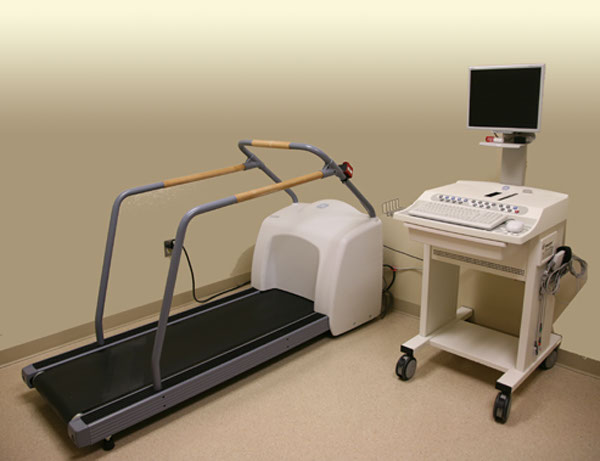
This test will show if you have chest or lung disease. This test requires that you breathe into a machine via a small mouthpiece. The breathing requirements range from small breaths to forceful breaths held for various lengths of time.
I am coming in for this test what can I expect?
This is a non-invasive test but could be uncomfortable at times if you have to hold your breath for a long period of time. Special instructions for this test are: No heavy meal prior to the test and no smoking 4 to 6 hours prior to test.
Indications:
- Wheezing
- COPD
- Bronchitis
- Shortness of breath
For more information click the link below:
What does the machine look like?
Breathing Machine with Mouthpiece

What is it?
An electrocardiogram (EKG) is a noninvasive, painless test doctors use to see the rhythm of your heartbeat.
I am coming in for this test what can I expect?
You lay in an exam room on the exam table with a gown over your chest and a nurse will attach 10 electrodes (little sticky things) around your chest, arm and legs. The test is ran and takes just a few minutes. A sheet will print out that shows your heart rhythm and the doctor will review this before he comes in the room to see you.
Indications:
Baseline test to see abnormalities and from this test more cardiovascular tests may be ordered
How do I prepare for the test?
No preparation is necessary. You will be required to remove any metal objects on your neck, arms and wrists.
For more information click the link below:
What does an Electrocardiogram look like?
EKG Cart (left) | EKG machine and leads (middle) | Sample EKG Results (Right)
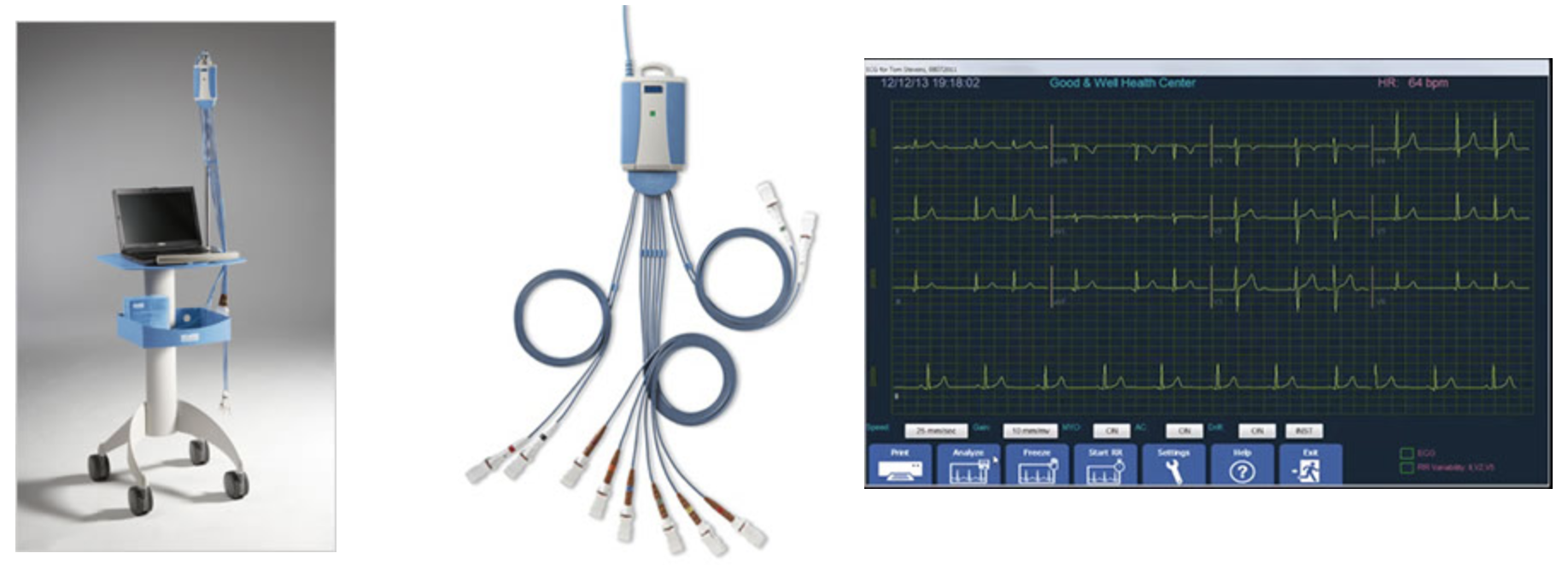
What is it?
Dexa Bone Density Scan – Dual energy X-ray absorptiometry uses xray to assess bone mineral density. This test can also be used in determining fat content and total body composition.
I am coming in for this test, what can I expect?
This test is non-invasive and basically you lie on a machine for about 20 minutes while it scans you with a small scanning arm that runs over your body. Nothing touches you and it doesn’t hurt a bit. The machine will print out a report that the doctor reviews. See what a DEXA Machine looks like by clicking here.
Is there any preparation?
Make sure you have had no nuclear medicine studies in the last 30 days. No hip replacements. Make sure you wear a 2 piece outfit with no metal in pants (zippers, etc.).
In cases of hip replacements, we can still do the study but will use a different technique involving the arm/forearm. The most important detail regarding hip replacements is to let the tech know prior to testing that you have had a hip replacement so the right technique will be performed. The hip prosthesis will cause artifact and make scan unreadable.
What does the machine look like?
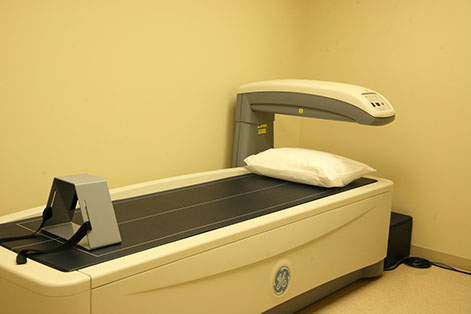
Laboratory
Seale Harris Clinic has met all criteria for Laboratory Accreditation by COLA, a national healthcare accreditation organization. Accreditation is given only to laboratories that apply rigid standards of quality in day-to-day operations, demonstrate continued accuracy in the performance of proficiency testing, and pass a rigorous on-site laboratory survey. Seale Harris Clinic has earned COLA accreditation as a result of a long-term commitment to provide quality service to our patients.
- Our lab is equipped to perform a variety of comprehensive diagnostic testing.
- Visit LabTestsOnline to learn more about what your lab results mean.
- Dr. Jeffrey J. Clifton serves as the clinic Lab Director.
X-Ray
All X-Rays at Seale Harris Clinic are completely digital. This means that your physician can view your x-ray on their computer moments after the x-ray has been taken. Seale Harris Clinic has invested in the best equipment to provide exceptional and efficient patient care.
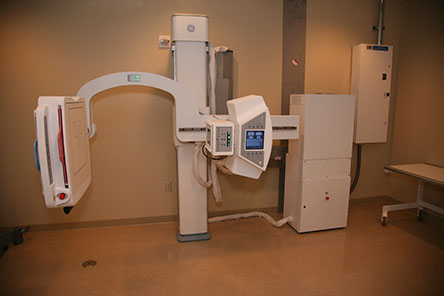
Ultrasound
Seale Harris Clinic does all forms of ultrasound in-house. There are a variety of different ultrasounds that focus on different parts of the body and all are done with the same equipment. Click on the different tests below for more information including what your physician is looking for when they order this test and any special preparation.
- Abdominal Vascular
- Carotid Ultrasound
- Echocardiogram
- Renal/Renal Vascular
- Thyroid Ultrasound
- Vascular Studies for the Legs
This is a test designed to observe blood vessels in your abdomen. This test is helpful in diagnosing an aortic aneurysm, or widening of the Aorta, it is also helpful in detecting stenosis or narrowing of the artery.
I am coming in for this test what can I expect?
During this exam, a qualified sonographer will use a transducer, along with warm gel, to take pictures of the Aorta and its branches. Doppler flow will be used to detect blood flow and evaluate any stenosis or narrowing of the vessel. During this exam you will be required to lie flat on your back for approximately 20 minutes. This is a painless non-invasive exam. Special instructions for this exam are: No food or drink 6 hours prior to the exam. A little water with medication is okay.
Indications:
- Hypertension
- High Cholesterol
- Kidney disease and
- History of Atherosclerosis
For more information click the link below:
What does the machine look like?
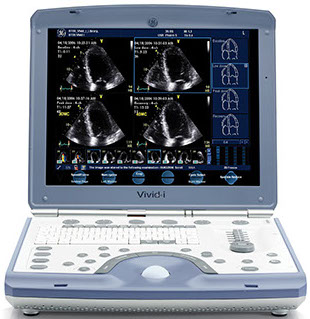
What is it?
Ultrasound or sonography exposes parts of the body to high frequency sound waves that produce pictures of particular areas of the body. This is a painless procedure that looks at the carotid arteries that flow up both sides of the neck.
I am coming in for this test, what can I expect?
There are no special instructions for this test other than wear loose fitting clothing and no jewelry. The test usually takes 30 minutes and if the doctor is seeing you after it could be a bit of a wait. Bring a book or magazine just in case you experience a wait.
Indications:
Carotid Doppler studies are used to demonstrate blocked or reduced blood flow in the arteries of the neck that could cause stroke. This test is also used to evaluate symptoms of dizziness, vision changes and loss of balance that may be caused by impeded or restricted blood flow through these vessels.
For more information click the link below:
This is an ultrasound of the heart that can help diagnose heart disease or heart defects. This is a non invasive procedure best described as the same procedure of ultrasound used to look at a baby.
I am coming in for this test what can I expect?
A patient coming in for this test can expect to lie flat on an exam table and the ultrasound technician will apply gel to the chest and upper abdomen area and use a transducer to capture the picture of the heart and blood flow of the heart. This ultrasound takes 15 to 20 minutes to complete and after the test your physician will go over the results with you.
Indications:
- Hypertension
- Chest pain
- Palpitations
- Shortness of breath
- Abnormal EKG
For more information click the link below:
This is a test used to evaluate the kidneys. Renal ultrasounds are useful in diagnosing kidney stones along with other abnormalities of the kidneys. During this exam a qualified sonographer will apply warm gel on your stomach and use a transducer to obtain images of your kidneys. Doppler ultrasound may also be used to evaluate the renal artery. This is the artery which supplies blood to the kidneys.
I am coming in for this test what can I expect?
This exam will require you to lie on your back and occasionally roll onto your sides. The exam should last approximately 20 minutes. This is a painless and non-invasive exam. You may be asked to take in a deep breath and hold it during the exam, this will help the sonographer get the best picture possible. Special instructions for this test are: no food or drink, other than water, 6 hours prior to the exam.
Indications:
- Hypertension
- Lower back or abdominal pain
- Abnormal urine or blood test
Important Facts:
Renal artery stenosis (RAS) is the narrowing of the lining of the main artery that supplies the kidney. Depending on the degree of narrowing, patients can develop hypertension called renal vascular hypertension (RVH). This form of hypertension is the most common cause of secondary hypertension.
RVH occurs when RAS produces a critical narrowing of the artery that supplies one of the kidneys.
For more information click the link below:
This is a test that is usually performed to examine an existing nodule or lump in the thyroid gland
I am coming in for this test what can I expect?
This is a painless and non-invasive test that will be performed on your neck and throat. A qualified sonographer will use a transducer and warm gel to examine and measure the thyroid gland. An ultrasound is useful in determining whether the lump or nodule is made of soft tissue or if it is a cyst, this will help your doctor diagnose a potential problem. There are no specific preparations for this exam, other than comfortable clothes and no jewelry. Approximately 20 minutes is needed for the exam.
Indications:
- Your doctor may suggest an ultrasound of the thyroid after a physical examination of your throat or abnormal blood tests.
For more information click the link below:
A vascular study is related to the blood vessels in your body. The vascular studies of your legs will allow proper visualization of the arteries and vein that supply your legs and feet with the necessary blood flow.
I am coming in for this test what can I expect?
Arterial Exam
You will be asked to change into a gown and remove pants, socks, and shoes. This will allow access to the entire leg. A qualified sonographer will use a transducer and warm gel to examine the artery in both legs beginning in the groin all the way to your ankle. Doppler ultrasound will be used to detect and observe the flow pattern in your legs.
Blood Pressure will be taken in your arms and legs to obtain an Ankle Brachial Index which will assist your doctor in detecting any vascular disease which may be present.
This is a non-invasive and painless procedure. The only preparation needed is comfortable clothing that is easy to change in and out of. Approximately 30 minutes is needed for the exam.
Venous Exam
During this exam you will be asked to change into a gown so that your entire leg is easily accessed. Using a transducer and warm gel, a qualified sonographer will begin in the groin area examining the major vein in your leg all the way to your ankle. You may feel slight pressure as the vein is compressed to ensure proper blood flow is present. This is a painless and non-invasive procedure that will last approximately 30 minutes. Doppler ultrasound will be used to detect and observe blood flow in the vein.
Similar exams are used to observe the arteries and veins in the arms as well.
Indications:
- The most common reason for this test is to rule out a blood clot in the major (deep) veins in your legs.
- Calf pain and swelling
- Kidney disease and
- History of Atherosclerosis
For more information click the link below:
Nuclear
Seale Harris Clinic was granted accreditation by The Intersocietal Commission for the Accreditation of Nuclear Medicine Laboratories (ICANL). Participation in the accreditation process is voluntary. Accreditation status signifies that the facility has been reviewed by an independent agency that recognizes the laboratory’s commitment to quality testing for the diagnosis of heart disease.
What is it?
Using a small amount of radioactive material injected into your blood stream, a nuclear stress test helps measure blood flow to your heart muscle during exercise and at rest.
I am coming in for this test, what can I expect?
Bring a comfortable pair of walking shoes or sneakers. Women, please try to wear a two piece outfit and avoid wearing a dress. Men, do not wear overalls or coveralls.
Indications:
- Abnormal EKG
- Chest pain
- Chest tightness
It is very important for you to bring your medications with you. Also, bring a written list of your medications. The test takes about 3 to 4 hours. You will be injected with a radioactive material and that will have to set in for an hour or so before you are tested. It would be a good idea to bring a book.
Is there any preparation?
Yes, you will need to follow the guidelines below:
- No Cialis for 7 days prior to the test. Avoid Viagra and Levitra for 24 hours before and after the test.
- No caffeine or decaf products 24 hours prior to the test. Avoid all soft drinks, chocolates, coffee and tea, including decaffeinated coffee and tea, which contain a small amount of caffeine.
- Take all medications as normal unless otherwise instructed by your physician. Note, before the stress test, your physician or our staff may instruct you to take or to withhold some of your medications; please follow their instructions. If you have questions regarding your medications, contact your physician or our office staff.
- DAY OF TEST do not eat or drink anything except water 4 hours prior to the stress test.
- DAY OF TEST do not smoke or use any tobacco products 4 hours prior to the stress test.
- DAY OF TEST do not use any nicotine products (i.e., patches, gum) 4 hours prior to the stress test.
Please inform us of any of the following so we can make sure the test is tailored for you:
- Asthma, asthmatic bronchitis, wheezing, emphysema or lung disease.
- Any pulmonary inhalers used recently or in the past or breathing treatments required. Bring any inhalers with you.
- Recent symptoms suggesting stroke, even if these went away.
- Any recent worsening of chest symptoms.
- Any Viagra, Levitra, Cialis taken within the last 7 days
- Any Persanntine, Dipyridamole or Aggrenox taken within the last week.
Please consult the list of Heart Rate Limiting Medications that you may need to stop taking prior to the test.
For more information click the link below:
What does the test look like?
